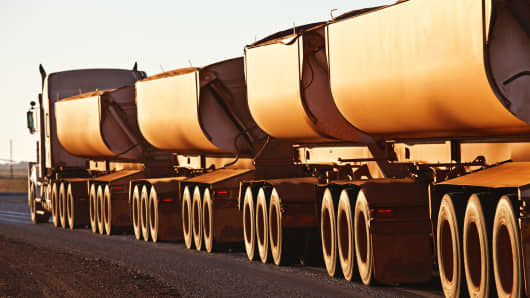Iron ore prices may extend gains from 16-month highs this week as forecasts predict a "severe" tropical cyclone crossing Australia's northwestern coast on later this week, possibly halting exports of the steel-making ingredient to Asian consumers and curtailing production in the Pilbara mining region.
Tropical Cyclone 'Rusty' "is moving slowly towards the coast" though "the slow motion of the cyclone means that the crossing time and location is uncertain," the Australian Bureau of Meteorology's Perth-based Tropical Cyclone Warning Center said in an update issued at 8:42 a.m. local time on Monday.
"Further intensification is likely as the cyclone approaches the coast on Monday and Tuesday and there is a high risk that it will cross the coast as a severe tropical cyclone," the Bureau said, adding that the system's slow movement means higher than usual rainfall in the Pilbara and western Kimberley. Widespread very heavy rainfall on Tuesday and Wednesday is likely to lead to major flooding in the De Grey catchment and significant flooding in the Fortescue is also likely, forecasts said.
(Read More: Suzlon '100% Confident' India Will Restore Wind Incentives)
ANZ warned in a daily market report on Friday that "potential weather-related disruptions" affecting the Pilbara and its iron ore export terminals may support iron ore prices. "Iron ore prices could further gain this week, as a severe tropical low crossing Australia's northwest coast is likely to intensify over the coming days," ANZ reiterated in its Monday report.
"The biggest problem is if there's any lasting damage to port or rail infrastructure," Nick Trevethan, ANZ's senior commodity strategist told CNBC on Friday. "That will have far more significant implications."
The potential destructive power of the current cyclone - which forecasters say could build into a Category 4 system by early Wednesday - may be far worse than last month's Category 1 storm (the weakest on a scale of one to five), which still forced the shutdown of all three iron ore export terminals.
"Category 1 shut all three ports and contributed to a 9 percent drop in exports for January," said Jonathan Barratt, chief executive of Barratt's Bulletin, a commodity markets newsletter in Sydney.
"Shutting down for 3 days plus could affect upwards of 20 percent of supply for the month and see spot prices higher," he told CNBC on Friday.
Likely to bear the brunt of the cyclone's force are Port Hedland, which handles about a fifth of the world's seaborne-traded iron ore and is used by BHP Billiton, Fortescue Metals Group and Atlas Iron, and the ports of Dampier and Cape Lambert, about 200 kilometers (124 miles) south of Port Hedland, used by Australia's biggest iron ore miner Rio Tinto.
(Read More: BHP Name News CEO as Profit Slumps)
"I checked forecasts for Port Headland and an extensive period of wet will last for a few days and up to two weeks and will affect exports of iron ore," Barratt said.
'Cyclone Alley'
The Pilbara region ships nearly half of the world's seaborne iron ore, mostly to China, Japan and South Korea. Australia's cyclone season runs from November to April and the region between Port Hedland and Dampier is known among mariners as "cyclone alley." At least half a dozen storms form there each season.
"This is the quarter where iron ore production typically gets impacted by weather-related events, so it's not unusual," said Gavin Wendt, senior resources analyst at Mine Life in Sydney. "There could be more bad weather on the way for Queensland coal as well, so we could be looking at a repetition of ongoing supply issues there too."
Despite forecasts predicting a destructive cyclone, some iron ore traders believe the market has already factored in the impact of the extreme weather. "It already priced in, I'd imagine, unless lasting damage is caused," said one trader. "It's a regular hazard in the region."
Another market watcher said he expected the price impact from the cyclone "to be less than 5 percent."
'Rusty' may trigger just a "short-term blip" higher for iron ore prices, Gaurav Sodhi, Resources Analyst, at Intelligent Investor in Sydney told CNBC's 'Squawk Box' on Monday, and won't alter the broader supply-led weakness in the market. There's a "high probability" of cutbacks by China steelmakers "not making returns on capital they want," he added.
Rio Tinto has closed its Cape Lambert export terminal and will shut the Dampier Port later Monday, Dow Jones reported.
When contacted by CNBC on Friday, BHP Billiton said the miner was not able to say whether it was shutting operations as a precautionary measure. "We continue to monitor cyclone activity closely to ensure the safety of our workforce at all times," the miner said in an emailed statement to CNBC on Monday.
(Read More: Australia's Fortescue Posts 40% Fall in H1 Net Profit)
"We always take a conservative approach to managing our operations in extreme weather situations," BHP said in an earlier email to CNBC on Friday. "We monitor all cyclone activity closely and shut in operations if we believe that is the safest course of action. We do not intend to give a daily update on the status of all our operations, but if there is any material impact on our production, we will report it in our quarterly production report."
The benchmark import price of 62 percent iron ore fines at China's Tianjin on Wednesday hit $158.90 a ton, the highest since mid-October 2011. The steel-making ingredient has been boosted by restocking by Chinese steelmakers - responsible for more than 60 percent of global consumption - and a draw down of inventory at the country's ports, the website Mining.com reported on Feb. 20.



